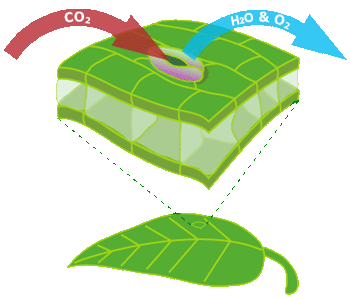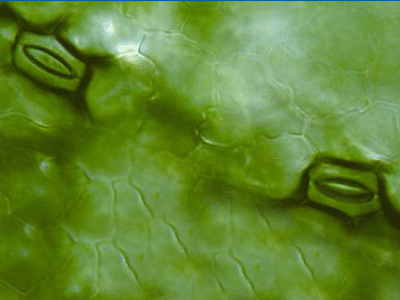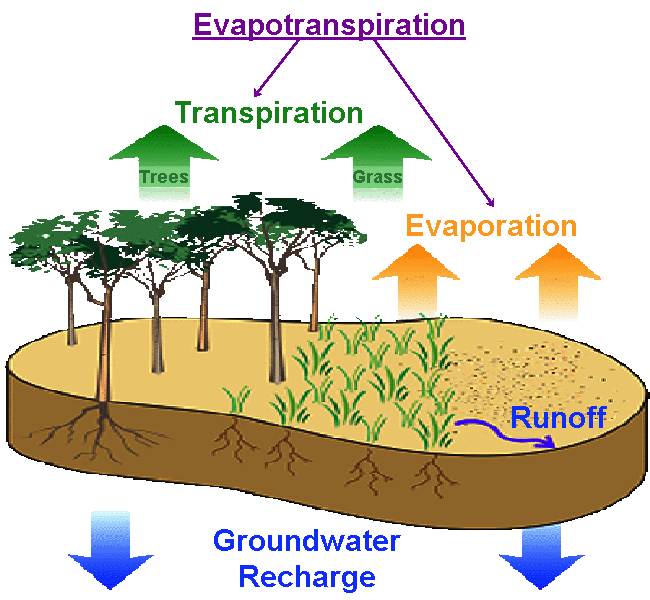About the Evapotranspiration and the Leef Wetness
|
The combination of two discrete processes in which there is loss of water at the one side from a soil surface evaporation (E) and at the other side the crop transpiration (T) is defined as Evapotranspiration (ET). Also another parameter, which is related to evapotranspiration, is the Leaf Wetness (LW). Evaporation (E) Evaporation is the process by which water in liquid phase is converted into water in gas phase (steaming) and evaporate from the surface (removal of steam). The water evaporates from a variety of surfaces, such as seas, lakes, rivers, roads, wet soils and vegetation. To change the state of water molecules from liquid to gas phase energy is required. The direct solar radiation and to a lesser extent, the temperature of the ambient air, supply the energy for this. The determining factor for remove water from the evaporating surface is the difference between the pressure from the water to evaporate and the pressure into the surrounding atmosphere. As evaporation proceeds, the surrounding air gradually becomes saturated and if the humid air is not transported in the atmosphere, the process slows down or stops. The replacement of saturated air with driest air depends largely extent by the wind speed. Therefore, solar radiation, air temperature, air humidity and wind speed are climatic parameters they must be taken into account when evaporation is calculated. Transpiration (T) Transpiration is the process by which water in liquid phase contained in plants tissues is converted into water in gas phase (steaming) and get removed as a vapor (steam) in the atmosphere. Crops mainly lose water through their stomata (Greek word: stoma=mouth, stomata=mouths). Stomata are small openings in leaves of the plants through which the gases and water vapor (steam) passes to the atmosphere. The water, together with some nutrients is absorbed by roots and transported through the plant to the leaves. The steaming occurs within the leaves, in the intercellular intervals, and vapor exchange with the atmosphere is controlled by the stomata diaphragm. Almost all the absorbed water, is lost by transpiration and only a small fraction is used by the plant. The transpiration depends on the suplied energy, the vapor pressure gradient and wind. Therefore, radiation factors, air temperature, air humidity and wind must be taken into account in the calculation of transpiration. The water content of soil and ability of soil to carry water to the roots also determine the transpiration, as well as flooding and salinity of subsurface water. The transpiration is affected also on the characteristics of the crop, environmental conditions and cultivation practices. Different plant species may have different transpiration.
Evapotranspiration (ET) Evaporation and transpiration occur simultaneously and there is no easy way of distinction between the two procedures. Apart from the availability of water in upper soil layer, the evaporation from a cultivated soil determined mainly by the fraction of solar radiation that reaches the surface of soil. This fraction decreases in the cultivation development period as the shade of growing up leaves take more and more territory. When cultivation is low, water is lost mainly from the soil evaporation, but once crop developed well and fully cover the soil, transpiration is the basic process.
Leaf Wetness (LW) The air humidity, water in gas form, comes in contact with a leaf, which is cold and converts into water to liquid form. When the temperature gets higher this water gets evaporeted and converts into gas form again. Also when it is raining a leaf gets wet. After the rain and when the temperature gets higher this rain water gets evaporeted and converts into gas form. The Leaf Wetness has an index from 0 to 15. 0 for dry and 15 for wet. |
|
The Evapotranspiration at Vouhead Weather Vouhead Weather is using the Kimberly-Penman equations to calculate
| |||||||||||||||||||||||||||||||||||||||||||||||















